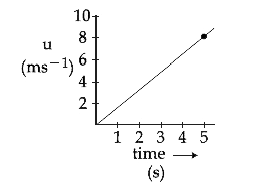A particle starts its SHM from mean position at t=0. If its time period is T and amplitude A then the distance traveled by the particle in the time from t=0→t=5T4 is
A
3A
4a
5A
The correct Answer is:D
5T4=T+T4
T - one full oscillation (4A)
TA−x=0⇒x=A
total distance = 5A
Topper's Solved these Questions
- OSCILLATIONSBook:NARAYNAChapter:OSCILLATIONSExercise:EXERCISE - II (C.W)
Explore 27 Videos
- OSCILLATIONSBook:NARAYNAChapter:OSCILLATIONSExercise:EXERCISE - II (H.W)
Explore 19 Videos
- OSCILLATIONSBook:NARAYNAChapter:OSCILLATIONSExercise:EXERCISE - I (C.W)
Explore 63 Videos
- NEWTONS LAWS OF MOTIONBook:NARAYNAChapter:NEWTONS LAWS OF MOTIONExercise:PASSAGE TYPE QUESTION
Explore 6 Videos
- PHYSICAL WORLDBook:NARAYNAChapter:PHYSICAL WORLDExercise:C.U.Q
Explore 10 Videos
Similar Questions
Knowledge Check
A particle starts its SHM from mean position at t=0. If its time period is T and amplitude A then the distance travelled by the particle in the time from t=0→t=5TA is
AAB3AC4AD5AIn Q.118, total distance travelled by the particle from t=0 to t=t0 is:
AA02αBA0αC2A0αD4A0αA particle starts SHM from the mean position. Its amplitude is A and time period is T. At the time when its speed is half of the maximum speed, its displacement y is
AA2BA√2CA√32D2A√3
The magnitude of displacement (in meters) by the particle from time t = 0 to t = t will be –
View SolutionThe speed verses time graph for a particle is shown in the figure. The distance travelled (in m) by the particle during the time interval t = 0 to t = 5 s will be __________

View SolutionA particle is moving along positive x direction and experiences a constant acceleration of 4m/s2 in negative x direction. At time t=3 second its velocity was observed to be 10m/s in positive x direction.
(a) Find the distance travelled by the particle in the interval t=0 to t=3s. Also find distance travelled in the interval t=0 to t=7.5s..
(b) Plot the displacement – time graph for the interval t=0 to 7.5s.
View SolutionA particle executes SHM of amplitude A and time period T The distance travelled by the particle in the during its phasde changes from π12 to 5π12 sin15=0.26,sin75=0.96
View SolutionPosition of a particle moving along x-axis is given by x=2+8t−4t2. The distance travelled by the particle from t=0 to t=2 is:-
View Solution